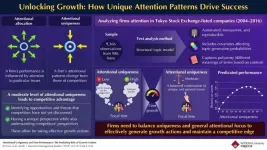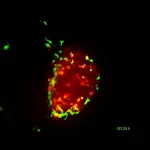(Press-News.org) As our climate changes and soil salinity increases in many agricultural areas, finding crops that can thrive in these challenging conditions is crucial. Cultivated tomatoes, while delicious, often struggle in salty soils. Their wild cousins, however, have evolved to survive in diverse and often harsh environments. A recent study delved into the genetic treasure trove of wild tomatoes to uncover secrets of salt tolerance that could be used to develop resilient crop varieties.
A team of researchers focused on Solanum pimpinellifolium, the closest wild relative of our beloved cultivated tomato. These tiny, cherry-sized fruits might not look impressive, but they pack a punch when it comes to genetic diversity and stress resistance.
The team began by exposing the wild tomatoes to varying levels of salt stress. Then, they used high-throughput phenotyping techniques in both greenhouse and field conditions to uncover extensive variations in how these plants responded to the salty conditions.
“One of the study’s most intriguing findings was that a plant’s overall vigor – its ability to grow quickly and robustly – played a significant role in its salt tolerance. This suggests that breeding healthier, more vigorous plants could indirectly improve their ability to withstand salt stress,” said Magda Julkowska, an assistant professor at the Boyce Thompson Institute and lead author of the study, which was recently published in The Plant Journal.
The researchers found that traits such as transpiration rate (the amount of water vapor a plant loses through its leaves), shoot mass (the weight of the plant's above-ground parts), and ion accumulation (the build-up of ions, such as sodium and potassium, within plant tissues) showed significant correlations with plant performance under salt stress. Interestingly, while transpiration rate was a key determinant of plant performance in the greenhouse, shoot mass strongly correlated with yield under field conditions.
“We were surprised to find that the amount of salt the plants accumulated in their leaves wasn’t as important to their overall performance as previously thought,” said Julkowska. “This challenges some existing ideas about how plants cope with salt stress and opens up new avenues for research.”
One of the most exciting findings was the identification of candidate genes not previously associated with salt stress tolerance. Julkowska added, "These specific genotypes can be used as allele donors for further improving crop performance and developing more sustainable agriculture."
The study contributes to a better understanding of salt stress tolerance in wild tomato species and lays the groundwork for further investigations into the genetic basis of these traits. The findings can inform breeding efforts for salinity tolerance in tomatoes and other crops. This could lead to expanded growing regions, more stable yields in the face of changing climates, and potentially tomatoes that require less water and fewer resources to cultivate.
While we might not see salt-loving tomatoes on supermarket shelves anytime soon, this research is a significant step toward creating a more resilient and sustainable food system. It's a powerful reminder that sometimes, the solutions to our most pressing agricultural challenges might be found in the wild relatives of the plants we already know and love.
This research was funded in part by the King Abdullah University of Science and Technology and the Australian Government under the National Collaborative Research Infrastructure Strategy (NCRIS).
About the Boyce Thompson Institute (BTI)
Founded in 1924 and located in Ithaca, New York, BTI is at the forefront of plant science research. Our mission is to advance, communicate, and leverage pioneering discoveries in plant sciences to develop sustainable and resilient agriculture, improve food security, protect the environment, and enhance human health. As an independent nonprofit research institute affiliated with Cornell University, we are committed to inspiring and training the next generation of scientific leaders. Learn more at BTIscience.org.
END
Unlocking the secrets of salt stress tolerance in wild tomatoes
2024-08-08
ELSE PRESS RELEASES FROM THIS DATE:
Detecting climate change using aerosols
2024-08-08
Climate change is one of the most significant environmental challenges of present times, leading to extreme weather events, including droughts, forest fires, and floods. The primary driver for climate change is the release of greenhouse gases into the atmosphere due to human activities, which trap heat and raise Earth’s temperature. Aerosols (such as particulate matter, PM2.5) not only affect public health but also influence the Earth's climate by absorbing and scattering sunlight and altering cloud properties. Although future climate change predictions are being reported, it is possible that the impacts of climate change could be more severe than predicted. ...
Exploring the impact of attentional uniqueness and attentional allocation on firm growth
2024-08-08
According to the attention-based view, a firm’s actions and growth performance are directly influenced by its attentional allocation to specific issues. The consequences of organizational attention are reflected in the firm’s strategic decision-making and adaptability. However, existing literature is limited in its exploration of how a firm’s attentional uniqueness impacts its behavior and performance. Notably, attentional uniqueness refers to how the firm’s attentional allocation diverges from competitors in the same industry.
To address the above-mentioned knowledge gap, Associate Professor Takumi ...
Breakthrough in molecular control: new bioinspired double helix with switchable chirality
2024-08-08
The deoxyribonucleic acid or DNA, the molecular system that carries the genetic information of living organisms, can transcribe and amplify information using its two helical strands. Creating such artificial molecular systems that match or surpass DNA in functionality is of great interest to scientists. Double-helical foldamers are one such molecular system.
Helical foldamers are a class of artificial molecules that fold into well-defined helical structures like helices found in proteins and nucleic acids. They have garnered considerable attention as stimuli-responsive switchable molecules, tuneable chiral materials, and cooperative supramolecular systems due to their chiral and ...
Saliva indicates severity of recurrent respiratory infections in children
2024-08-08
A saliva test can more accurately indicate the severity of recurrent respiratory infections in children than the standard blood test. If saliva contains too few broadly protective antibodies, a child is more likely to suffer from pneumonia episodes. This is reported by researchers from Radboudumc Amalia Children's Hospital and UMC Utrecht Wilhelmina Children's Hospital in the European Respiratory Journal. Saliva testing provides valuable information for treatment and is more comfortable for children.
About ...
Short, intense bursts of exercise more effective after stroke than steady, moderate exercise
2024-08-08
Research Highlights:
Researchers found repeated one-minute bursts of high-intensity interval training were more effective than traditional, moderate continuous exercise for improving the body’s aerobic fitness after a stroke.
Fitness level improvements doubled in participants in the high-intensity interval training group compared to those in the moderate intensity exercise group.
Researchers found the level of fitness changes in the high intensity interval training group were associated with improved survival and lower risk of stroke-related ...
Imaging technique uncovers protein abnormality in motor neurone disease
2024-08-08
Pathological abnormalities associated with motor neurone disease have been identified using a new technique developed at the University of Birmingham.
The method will help scientists better understand the changes in the brain that lead to motor neurone disease (MND) and could eventually yield insights that will help with the development of new treatments. The abnormalities were identified in a collaboration between the University of Birmingham and the University of Sheffield and published today [8 Aug] in Nature Communications.
Motor neurone disease, also known ...
Scientists unravel how the BCG vaccine leads to the destruction of bladder cancer cells
2024-08-08
Using zebrafish “Avatars”, an animal model developed by the Cancer Development and Innate Immune Evasion lab at the Champalimaud Foundation (CF), led by Rita Fior, Mayra Martínez-López – a former PhD student at the lab now working at the Universidad de las Américas in Quito, Ecuador – and colleagues studied the initial steps of the Bacillus Calmette-Guérin (BCG) vaccine’s action on bladder cancer cells. Their results, which are published today (August 1, 2024) in the journal Disease Models and Mechanisms, show that macrophages – the first line of ...
Cleveland Clinic study adds to increasing evidence that sugar substitute erythritol raises cardiovascular risk
2024-08-08
August 8, 2024, Cleveland: New Cleveland Clinic research shows that consuming foods with erythritol, a popular artificial sweetener, increases risk of cardiovascular events such as heart attack and stroke. The findings, from a new intervention study in healthy volunteers, show erythritol made platelets (a type of blood cell) more active, which can raise the risk of blood clots. Sugar (glucose) did not have this effect.
Published in Arteriosclerosis, Thrombosis and Vascular Biology, the research adds to increasing evidence that erythritol may not be as safe as currently ...
Microscopy technique “paves way” for improving understanding of cellular functions
2024-08-08
Scientists have developed a new way of counting labelled proteins in living cells that could become a standard and valuable tool in the field of biomedical research.
This powerful new technique, known as Protein-tag Degree of Labelling (ProDOL), provides a robust and versatile approach for precisely determining labelling efficiencies, the number of proteins that are labelled with fluorescent markers in living cells, in microscopy, a crucial aspect of protein quantification in biological research.
The method ...
Microbes conquer the next extreme environment: Your microwave
2024-08-08
Since the industrial revolution, microbes have successfully colonized one novel type of habitat after another: for example marine oil spills, plastic floating in the oceans, industrial brownfields, and even the interior of the International Space Station.
However, it turns out that one extreme environment harboring a specialized community of highly adapted microbes is much closer to home: inside microwaves. This finding has now been reported for the first time in a study in Frontiers in Microbiology by researchers from Spain. It’s not only important from the perspective of ...





